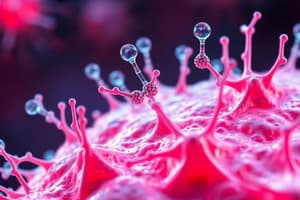Podcast
Questions and Answers
Which process is primarily responsible for increasing glucose uptake in muscle and adipose cells upon insulin receptor activation?
Which process is primarily responsible for increasing glucose uptake in muscle and adipose cells upon insulin receptor activation?
- Hydrolysis of GTP
- Activation of PKB (correct)
- Dimerization of the receptor
- Degradation of cAMP
What does cAMP, as a second messenger, primarily regulate within signaling pathways?
What does cAMP, as a second messenger, primarily regulate within signaling pathways?
- Down-regulation of receptors
- Amplification of the initial signal (correct)
- Formation of lipid derivatives
- Degradation of proteins
What role does phosphodiesterase (PDE) play in the cAMP signaling pathway?
What role does phosphodiesterase (PDE) play in the cAMP signaling pathway?
- Termination of cAMP signal (correct)
- Activation of adenylyl cyclase
- Release of calcium ions
- Synthesis of cAMP from ATP
What structural change occurs to the insulin receptor upon insulin binding?
What structural change occurs to the insulin receptor upon insulin binding?
How does the hydrolysis of GTP to GDP affect the G-protein coupled receptor signaling pathway?
How does the hydrolysis of GTP to GDP affect the G-protein coupled receptor signaling pathway?
Which type of signaling involves the secretion of hormones into the blood?
Which type of signaling involves the secretion of hormones into the blood?
What role do second messengers play in signal transduction?
What role do second messengers play in signal transduction?
What is the outcome of ligand binding to a membrane receptor?
What is the outcome of ligand binding to a membrane receptor?
In which signaling type does a chemical messenger act on the same cell that secreted it?
In which signaling type does a chemical messenger act on the same cell that secreted it?
What condition results from antibodies being produced against acetylcholine receptors?
What condition results from antibodies being produced against acetylcholine receptors?
Which of the following accurately describes paracrine signaling?
Which of the following accurately describes paracrine signaling?
What is the primary effect of signal termination in a signaling pathway?
What is the primary effect of signal termination in a signaling pathway?
What is the primary function of cytokines in the immune response?
What is the primary function of cytokines in the immune response?
What type of molecules are neurotransmitters primarily classified as?
What type of molecules are neurotransmitters primarily classified as?
Which of the following are classified as hormones?
Which of the following are classified as hormones?
What type of receptors utilize JAK/STAT signaling pathways?
What type of receptors utilize JAK/STAT signaling pathways?
Which eicosanoid is primarily involved in vasodilation?
Which eicosanoid is primarily involved in vasodilation?
What is a characteristic of signaling through receptor protein kinases?
What is a characteristic of signaling through receptor protein kinases?
Which class of kinases involves the use of Smad proteins?
Which class of kinases involves the use of Smad proteins?
What process is initiated when signaling molecules bind to cell surface receptors?
What process is initiated when signaling molecules bind to cell surface receptors?
Which option describes the role of GEF in tyrosine kinase signaling?
Which option describes the role of GEF in tyrosine kinase signaling?
Flashcards are hidden until you start studying
Study Notes
Chemical Messenger Systems
- Chemical messenger systems involve secretion of substances by cells that travel to target cells to elicit responses.
- Types of signaling:
- Endocrine: Hormones released into the bloodstream.
- Paracrine: Messengers act on nearby cells.
- Autocrine: Messengers act on the same cell that secreted them.
Types of Messengers
- Neurotransmitters: Small nitrogen-containing molecules secreted into synaptic clefts or blood for communication between neurons.
- Cytokines: Small proteins involved in immune response, activating gene transcription and killing invading organisms (e.g., interferons, TNF).
- Eicosanoids: Derived from arachidonic acid; function in injury response; examples include prostacyclin leading to vasodilation.
- Hormones: Include polypeptides (insulin), catecholamines (epinephrine), steroid hormones (derived from cholesterol), and thyroid hormones.
Intracellular Signaling and Transcription Factors (TFs)
- Receptor types include cell surface and intracellular receptors; affect cell function and gene expression.
- Cell surface receptors interact with extracellular environment, initiating signaling pathways upon binding signaling molecules.
Signal Transduction Pathways
- Signaling pathways are unidirectional from the cell surface to the nucleus.
- Membrane receptor classes:
- Ion-channel receptors: Open in response to ligand binding.
- Receptors with second messengers: Utilize amplification of signals.
- Receptor protein kinases: Phosphorylate proteins to alter functions and gene expression.
Specific Signaling Mechanisms
- JAK/STAT Pathway: Cytokine binds receptor, activates JAKs, and phosphorylates STAT proteins which dimerize and enter the nucleus.
- Serine-threonine Kinase Pathway: Ligand binds, phosphorylates receptors that activate R-Smad, leading to gene expression regulation.
- Tyrosine Kinase Pathway: Growth factors bind, receptor dimerizes and activates adaptor proteins, triggering a signaling cascade via Ras activation.
Single Receptor Signaling Diversity
- Insulin Receptor can signal multiple pathways: activates PI-3 K to increase PIP3, enhancing glucose uptake and altering gene expression patterns.
GPCR Signal Transduction
- G-protein coupled receptors bind small molecules, affecting second messenger concentrations, significantly amplifying signals.
- Ligand binding leads to GTP replacing GDP on the alpha subunit, activating adenylyl cyclase which produces cAMP.
Second Messengers
- cAMP: Key player in many signaling pathways, derived from ATP.
- DAG and IP3: Involved in other GPCR signaling pathways; IP3 stimulates calcium release and associated protein activation.
Signal Termination
- Signal termination is crucial for regulation of signaling pathways and can occur through:
- Degradation or diffusion of messengers.
- Down-regulation or phosphorylation of receptors.
- Depletion of second messengers.
Studying That Suits You
Use AI to generate personalized quizzes and flashcards to suit your learning preferences.



